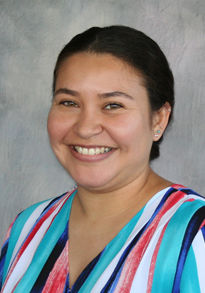Maricela Cruz, PhD
Biography
Maricela Cruz, PhD, strives to create useful and widely applicable methodology to tackle real-world problems in public health. Her research primarily focuses on developing novel statistical methods to assess and evaluate the impact of complex health care interventions. In her research, she uses statistical techniques for interrupted time series, time series, correlated data, change point detection, longitudinal data and interventions research.
Dr. Cruz received her PhD in statistics from the University of California Irvine. During her time there, she was a National Science Foundation Graduate Research Fellowship awardee and Eugene Cota-Robles fellow. She worked with care delivery experts and practitioners to design and conduct statistical analyses that assessed health care interventions across multiple hospitals and hospital units. She developed two novel interrupted time series models that allow for complex correlation structures that can change post intervention and are adequate for single- and multi-unit continuous data. To communicate and encourage access to her methods by non-statisticians in the broader public health community, Dr. Cruz produced an application in R Shiny that analyzes interrupted time series data. As a graduate student, she was a summer associate at the RAND Corporation. While at RAND, she led a collaborative study examining the relationship between group cohesion and climate with alcohol use outcomes in a group therapy intervention for individuals with a first-time offense for driving under the influence.
At KPWHRI, Dr. Cruz works alongside researchers in behavioral health, mental health, and insurance design. She explores the relationship between weight change and diabetes measures and the built environment, aids in the development of suicide risk prediction algorithms, and evaluates interventions that encourage high-value use of health care services.
RESEARCH INTERESTS AND EXPERIENCE
Recent Publications
Yeung L, Cruz M, Tsiao E, Watkins JB, Sullivan SD. Drug use and spending under a formulary informed by cost effectiveness. J Manag Care Spec Pharm. 2023 Nov;29(11):1175-1183. doi: 10.18553/jmcp.2023.29.11.1175. PubMed
Simon GE, Cruz M, Shortreed SM, Sterling SA, Coleman KJ, Ahmedani BK, Yaseen ZS, Mosholder AD. Stability of suicide risk prediction models during changes in health care delivery. Psychiatr Serv. 2023 Aug 17:0. doi: 10.1176/appi.ps.20230172. [Epub ahead of print]. PubMed
Shortreed SM, Walker RL, Johnson E, Wellman R, Cruz M, Ziebell R, Coley RY, Yaseen ZS, Dharmarajan S, Penfold RB, Ahmedani BK, Rossom RC, Beck A, Boggs JM, Simon GE. Complex modeling with detailed temporal predictors does not improve health records-based suicide risk prediction. NPJ Digit Med. 2023;6(1):47. doi: 10.1038/s41746-023-00772-4. PubMed
Cruz M, Ombao H, Gillen DL. A generalized interrupted time series model for assessing complex health care interventions. Stat Biosci. 2022;14(3):582-610. doi: 10.1007/s12561-022-09346-6. Epub 2022 May 25. PubMed
Cruz M, Drewnowski A, Bobb JF, Hurvitz PM, Moudon AV, Cook A, Mooney SJ, Buszkiewicz JH, Lozano P, Rosenberg DE, Kapos F, Theis MK, Anau J, Arterburn D. Differences in weight gain following residential relocation in the Moving to Health (M2H) study. Epidemiology. 2022 Sep 1;33(5):747-755. doi: 10.1097/EDE.0000000000001505. Epub 2022 May 20. PubMed
Research

Suicide attempts decreased after adding suicide care to primary care
Safety planning and risk screening improved outcomes for adult patients.
Research

Neighborhood density connected to changes in body mass index for children
Study uses geographic data to track change over time.
KPWHRI in the media
Addressing structural racism in clinical prediction models
How structural racism is impacting clinical prediction models
JSM TV, Aug. 6, 2024



